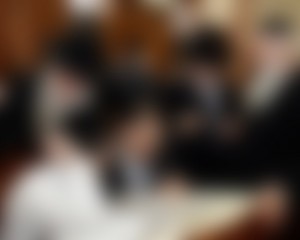
“…seven cows of beautiful appearance and robust flesh…” (41:2)
Pharaoh dreams that as he is standing over the Nile seven cows “y’fos mareh” – “of beautiful appearance” and “briyos bassar” – “robust flesh” emerge from the river. Subsequently, seven other cows, ugly and gaunt, emerge and consume the beautiful and robust cows. Yoseif interprets that the first seven cows represent seven years of abundance, which are to be followed by seven years of famine, represented by the second set of cows. Most of the commentaries see a correlation between the cows and the Egyptian economy. Being an agricultural society, Egypt’s economic wellbeing is defined in terms of their livestock; abundance results in well-fed animals while famine results in malnourished animals.1 However, Rashi chooses to explain the symbolism in a different manner. Rashi’s comment on the expression “y’fos mareh” – “of beautiful appearance” is that it alludes to the years of “sovah”, when people will view each other favorably.2 Clearly, Rashi is teaching that the cows represent the people and not the livestock owned by the Egyptians. What prompts Rashi to interpret the verse differently than most of the other commentaries? If, according to Rashi, the cows represent the people’s attitudes towards one another, how do we interpret the latter half of the verse “briyos bassar” – “robust flesh”? The term used by the Torah for the years of plenty is “sova”. Rashi understands that “sova” does not only refer to abundance, but contentment as well. Contentment is not gauged by the state of the economy alone; it is a state of mind. If a person is able to view another’s success favorably, then he is truly content. Many people have more resources than they will ever need, but still begrudge others their success. They become so consumed with the success of others, that they forget their own accomplishments and are therefore unable to find satisfaction in the fruit of their labor. Therefore, Rashi identifies the “sova gadol” – “a time of great contentment” as a time when people are able to view each other favorably. This concept is alluded to by the seven cows “y’fos mareh” – “of beautiful appearance”. Rashi’s interpretation is corroborated by the comments made by the Midrash on the end of the verse “vatirenah b’achu” – “and they were grazing in the marsh”. The Midrash comments “ahava ve’achva ba’olam” – “it is a time of love and brotherhood in the world”.3 One person can view another favorably only if he sees himself in a healthy light. Self-respect coupled with the ability to gauge ourselves by our own accomplishments allows us the security to share in the happiness and success of others. This is alluded to by the description of the cows “briyos bassar” – “robust flesh”, for they have a healthy disposition. If a person does not have self-respect and can only gauge his own accomplishments in terms of others’, he will be forever threatened by their success and therefore never rejoice in his own.
1.Ramban 41:2 2.Rashi ibid. 3.Bereishis Rabbah 89:4
Welcome to the J.C.C of Mt. Moriah
The Mishna in Midos relates that the Greeks breached the walls surrounding the Beis Hamikdash in thirteen places.1 Chazal view these breaches as symbolic of the chasm created by the Greeks within the Jewish people as a result of their attempts to eradicate Torah observance. The Talmud states that King Solomon was taken to task for sealing breaches in the wall surrounding the Beis Hamikdash, for doing so inhibited access to Jewish pilgrims.2 If the breaches in the wall allowed greater accessibility to the Beis Hamikdash, why were the breaches created by the Greeks viewed in such a negative light? The Talmud states that two contributing factors in the death of the ignorant is their reference to the “Holy ark” as “arna” – “a closet” and naming their houses of worship “Beth Am” – “House of the People”.3 Why are these actions considered shortcomings? What is the connection between the two behaviors? In Hilchos Beis Habechira the Rambam records as the source of the obligation to build the Beis Hamikdosh the verse in Parshas Teruma “v’asu li mikdosh” – “make for Me a sanctuary”.4 The Lechem Mishna comments that the Rambam appears to be contradicting himself, for in Hichos Melachim the Rambam cites the verse “l’shichno sidreshu u’vasah shama” – “you shall seek out His Presence and come there”.5 How do we reconcile this contradiction? The Beis Hamikdosh served two main functions. In addition to functioning as a place for Bnei Yisroel to serve Hashem, it was also the center for the entire nation to gather three times a year to express their unity and solidarity. The verses cited by the Rambam reflect these two functions. The verse “l’shichno sidreshu u’vasah shama” – “you shall seek out His Presence and come there” emphasizes the need for a place for the nation to gather.6 The Rambam cites this verse in Hilchos Melachim together with the monarchial responsibilities, for the king serves to unite the nation. In Hilchos Beis Habechira which records the various elements of service found in the Beis Hamikdosh, the Rambam records the verse “v’asu li mikdosh” – “make for Me a sanctuary” for this reflects the requirement to have a place of service.7 Both of these requirements compliment one another for the only true unifying force that the Jewish Nation has is their commitment to uphold their spiritual heritage. It is because the Beis Hamikdosh is a place of service that it can also function as the rallying point for Bnei Yisroel. The Levush explains that the reason why we celebrate Chanukah with “hallel v’hoda’ah” – “praise and thanksgiving” whereas Purim is celebrated by “se’udah u’mishteh” – “festive meals” is that the Greek threat was not a physical one, rather an attempt to eradicate any vestige of spirituality from our lives. Therefore, we celebrate in a spiritual manner, “hallel v’hoda’ah”. On Purim our physical existence was at stake, prompting our celebrating in a physical manner.8 The Greeks were not attempting to destroy our national identity, rather they wanted to preserve Judaism as a culture devoid of spirituality. The breeches made to the Temple were to create greater accessibility to it. The Temple was to serve as a great cultural center. All the rules and regulations restricting entry to those who were spiritually contaminated were to be abolished. No longer were the “archaic” laws of sanctity and purity to be heeded. Such a course of action would be catastrophic to the Jewish people, for without our commitment to spirituality we could not survive. Under the leadership of Solomon, Bnei Yisroel had a king and Temple that unified us spiritually. Since all laws of sanctity were being observed, the decision to limit the pilgrims was merely political. Therefore, limiting access to the Temple was the wrong course of action. The Talmud castigates those who name their houses of worship “Beth Am” – “House of the People” for they fail to realize that it is the worship that unifies the nation and not our culture. Similarly, referring to the “Aron Hakodesh” as a “closet” reflects the view that the Torah is no more than a mere cultural artifact, a history book. Jews from different parts of the world do not share a common culture or language. It is only their spiritual legacy and commitment that binds them. By emphasizing culture over worship, the house of worship becomes a glorified community center, slowly being drained of its spirituality. It is then that the Maccabees’ victory over the Hellenistic forces must be re-examined.
1.2:3 2.Sanhedrin 101b 3.Shabbos 32a 4.1:1 5.1:1 6.Devarim 12:5 7.Shemos 25:8 8.Orech Chaim 670


